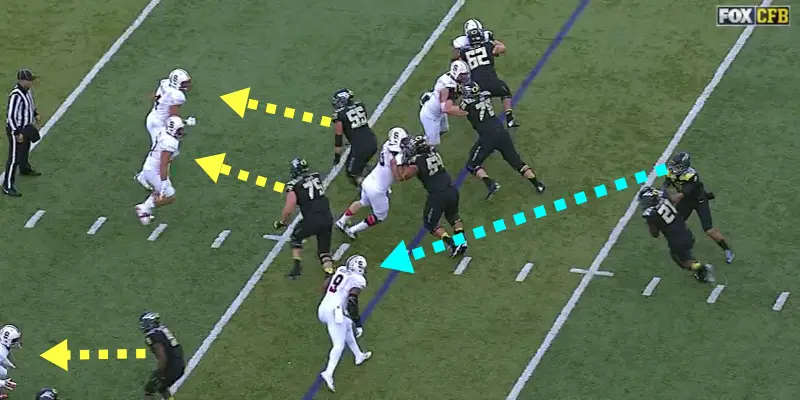Oregon has changed its foundation play, the Inside Zone Read, from how they ran it three years ago! I covered part of it in a recent discussion about the components of the Pistol offense being added to Oregon Spread Offense, but we need something that covers this essential play from the perspective of how Duck running backs learn to read the blocking and choose the correct gap to run through.
This recent game against Stanford featured all three running back tactics, and while I predicted before the game that we would see a heavy dose of this play, I didn’t expect to see so many nice variations in one contest. It also behooves us to understand this NEW Inside Zone Read since UCLA, Cal, and Utah have copied it from Oregon and they ran the new version this last weekend in their games.
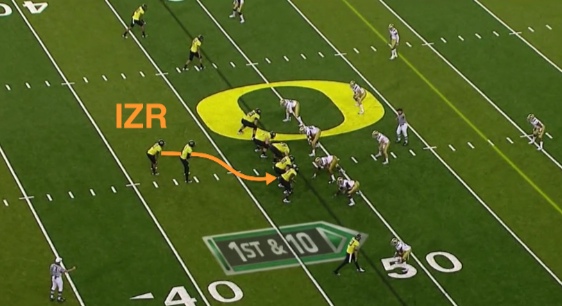
“The Way we Were…”
The screenshot above was taken from my original Inside Zone Read explanation and video from the summer of 2011. Note how the path of the play was to the gap between the guard and tackle (the B Gap) and the opposite side of where the running back lined up in the backfield. On occasion we still do this to confuse the defense, but we almost always run the NEW version of the Inside Zone Read.

A new path…
In the new version (above) the running back lines up to one side and slightly behind the quarterback and instead of crossing his face and going to the “B” gap on the opposite side, he is instead moving toward the QB and then lining up straight to go forward with the mesh taking place with the RB, perpendicular to the LOS as opposed to parallel.

Stanford slants their defensive line…
The red arrows (above) refer to the Cardinal defensive line slant taking place on this play and Oregon’s offensive line has to adjust. Note how Marcus appears to be looking outward as if to be Zone Reading a defender…but he is not. The Stanford defensive linemen are all being blocked at the LOS. All the unblocked defenders are too far away to be chasing the Duck RB, hence this is not an Inside Zone Read play, but simply an Inside Zone.
Why would they take away the option of Mariota pulling the ball? The coaching staff is clearly being selective as to when they give Marcus the green light to run, and thus are protecting the most important asset on the team. They want to use his speed, but not every play and expose him to injury, and I applaud that strategy!
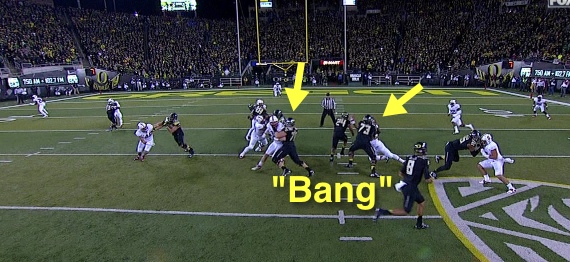
A thing of beauty to a true “Next Level” Oregon football fan!
Good grief, look at the blocking above against one of the best defenses in the nation! You’ll note No. 73 under the right yellow arrow is Freshman Tyrell Crosby, and No. 78 on the left yellow arrow is Cameron Hunt, a sophomore. The running back in the middle, No. 24 is sophomore Thomas Tyner! Good blocking and running will continue at Oregon with such youth performing so well.
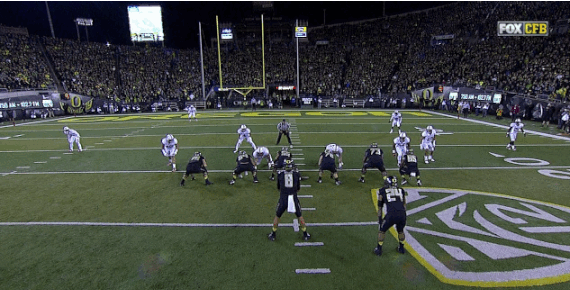
The new path of the Running back in the Inside Zone/Inside Zone Read play.
The ball (above) was snapped originally on the left side of the hash marks, and Tyner is running right up to almost precise point from where the ball is snapped! That, my feathered friends is what many coaches call the “Bang” option of the new Inside Zone and Inside Zone Read. If the middle is open the RB “bangs” it up the middle.
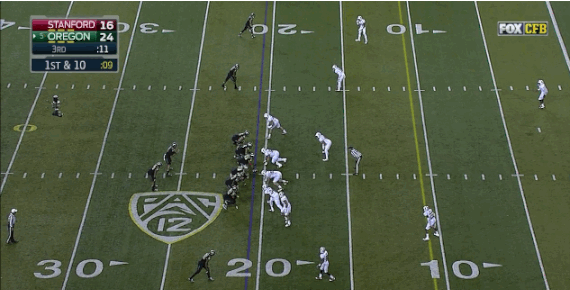
“Banging it” is not vulgar when you’re talking football.
Not only does Thomas Tyner explode up the middle easily (above), but when he does encounter the safety he reveals a new spin move to elude the Cardinal defender for the touchdown!

Not the best sight in front of the Duck RB!
In a new play (above) we see the RB taking the handoff, but immediately sees a Stanford Middle Linebacker right in front of him. He can’t “Bang” it on this play! Note also, another Cardinal LB to the left of the MLB where normally Oregon’s right tackle will come out to meet him, but the slant by the Stanford defensive line has caught up the Duck tackle “in the wash” as they say (and that is why defenses do that–to keep their LBs free to make tackles immediately).
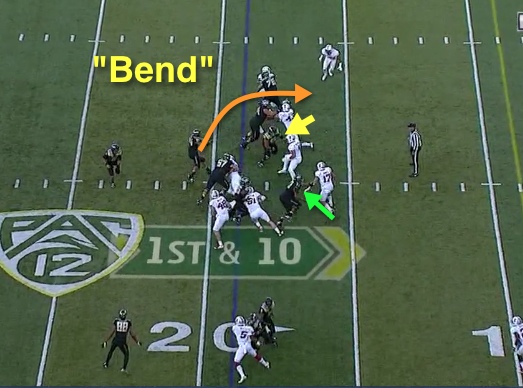
This is not Beckham, but bending it Oregon style.
The Oregon RB has decided to “Bend” the Inside Zone play by turning on a dime and bolts to the left of the Stanford linebackers. Hroniss Grasu is now releasing from his block to go out and blast the MLB of the Cardinal, but in the split second that Thomas Tyner had to make a decision–there was no assurance that Grasu could leave his initial block (Yellow arrow). The green arrow shows how Tyrell is out there, but unable to get to the Stanford LB in time; it happens.
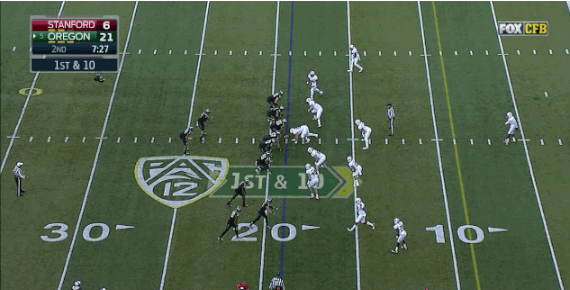
Way to read the blocks and “bend” it!
It is very apparent (above) that Tyner made the right choice as the Cardinal LBs would have had the middle gap plugged for almost no gain, but by “Bending” the run to the left, the Ducks pick up seven yards on first down! It takes great vision and instincts to make this cut, and LaMichael James was extraordinary at it, although “bending” with the old Inside Zone Read was cutting back against the over-reaction of defenders coming one direction.
The New Inside Zone Read forces the defenses to line up balanced, thus they generally don’t over-pursue the way we noted “in the old days” of 2-3 years ago. It is fun to see the blocking and a great decision bring a nice gain!
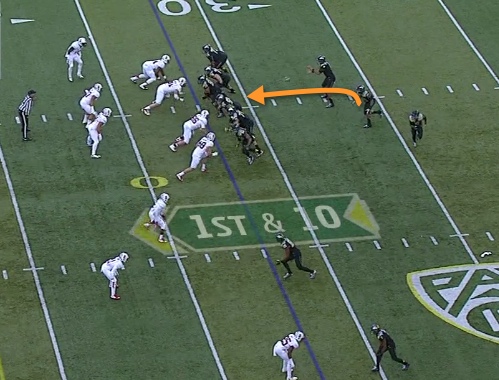
Pretty routine beginning…
This play above began with two RBs behind and on each side of Mariota, but one has gone in motion as a potential Bubble pass receiver. The Oregon RB left in the backfield is beginning the usual movement to run the new Inside Zone Read and he will see ALL the gaps on the LOS to choose which one to run to.

Do you have the speed to “bounce?”
Whoa! After receiving the handoff and approaching the LOS–there are Cardinal defenders plugging all the gaps for the Duck RB to run to, hence the “Bounce” option to cut hard to the right and run to the sideline asap (Orange arrow)!
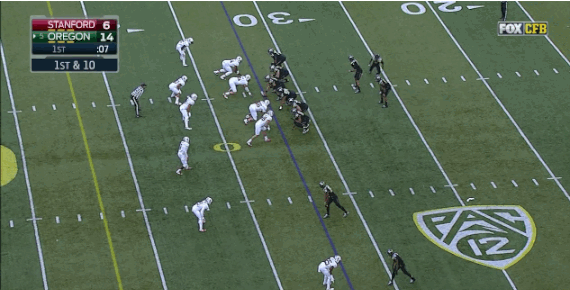
The “Bounce” tactic works best with superior speed…
The Oregon RB not only makes it to the sidelines (above), but with his speed he has a twelve yard gain before being pushed out. So we have seen how a RB can run up the middle (Bang it), or run to the left (Bend it), or run to the right (Bounce it). When Oregon has good zone blocking and the RB has good vision–Oregon can make great yardage even when it appears the gaps are filled.
Note also the RB featured in all three examples; Thomas Tyner has not got all the game time experience that many other RBs at Oregon have had early on, but it is apparent that he has mastered all three Inside Zone, and Inside Zone Read running tactics by reading the blocks and picking the gap to explode through. I am delighted to see his progress!
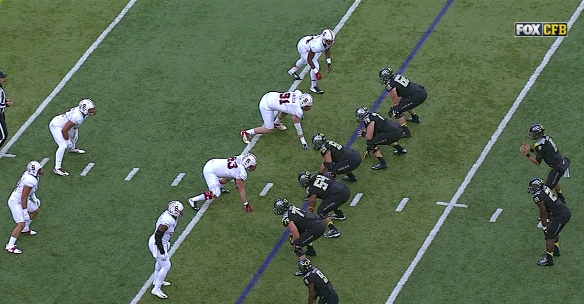
Routine-six defenders in the box…
All three of the prior examples had NO ZONE READING in those plays. They were simply Inside Zone plays that had different results due to the blocking and gap selection by the running back.
Above we see the beginning of a play where the clamps are taken off Marcus as he actually gets to do a Zone Read, and if it is open he has the green light to run. The beginning of this play is typical–six Stanford defenders in the “box.”
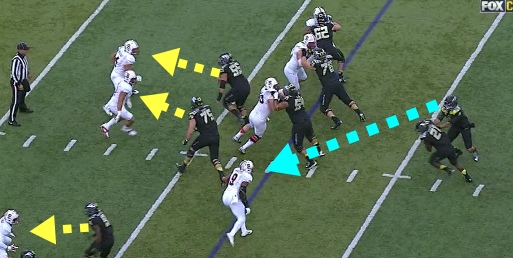
Aahh, the classic Zone Read again!
How classic is this screenshot above? We have featured TONS of these over the last three years as we see Marcus, Zone Reading (Light blue dotted arrow) the unblocked Cardinal defensive end, while Pharaoh Brown, Jake Fisher, and Hroniss Grasu go out to meet their blocking assignments.
Mariota is reading the intentions of the Stanford defensive end; if he “sits” then Marcus will hand off and let the RB decide which gap as described before.
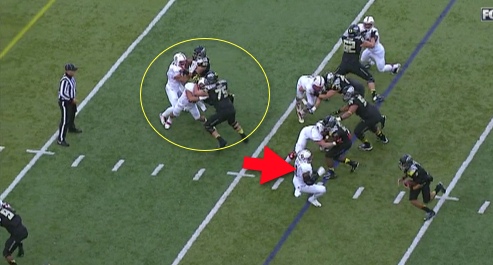
The Stanford DE made a Cardinal error!
Oh baby, that Cardinal defensive end crashed too hard inside (Red arrow above) and Marcus could see that he can beat the DE to the outside, hence pulling the ball. Look at the yellow circle as you see the veterans have their linebackers under control.
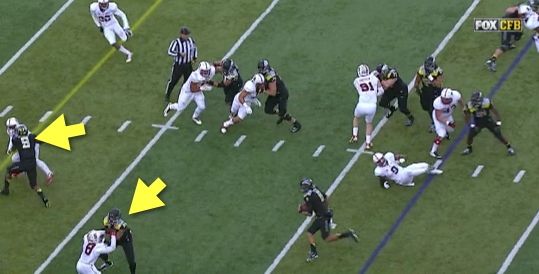
Blocking heaven.
This screenshot above makes me want to pretend it is the end of the third quarter at Autzen and stand up and SHOUT at all the great blocking! Brown, Byron Marshall, and the offensive linemen have created a lane for Mariota to run through. Beautiful.
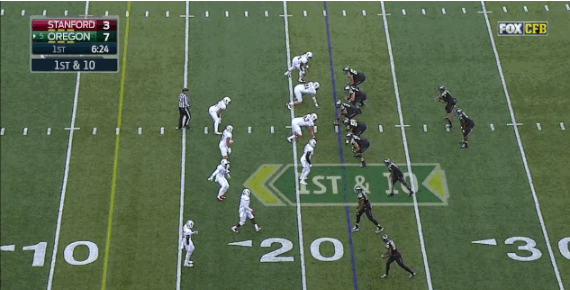
What a sweet touchdown from so many angles…
As if the blocking wasn’t good enough–we see Dwayne Stanford, the perfect name for this game, No. 88 laying a block on the safety near the end of the play to finish the touchdown run for Marcus Mariota. When the coaches let Marcus run it on occasion…the impact is huge and yet the number of times he runs per game is actually quite low. The THREAT of him running ties up the opponent’s defense, and when he does run — it changes the game. Wow.
The benefit of the NEW Inside Zone Read is evident; the running back can see the entire line of scrimmage and pick the best gap to attack as opposed to running to the predictable same gap each time. This new variation has made it easier for the offensive linemen (Block the defenders to where they want to go and the RB will cut off of them.), and easier for the RB to read the hole and make more yardage. The only players now at a disadvantage are on the opposing defenses!
“Oh how we love to learn about our beloved Ducks!”
Charles Fischer (FishDuck)
Oregon Football Analyst for CFF Network/FishDuck.com
Eugene, Oregon
Top Photo from Video
Related Articles:

Charles Fischer has been an intense fan of the Ducks, a season ticket holder at Autzen Stadium for 35 years and has written reports on football boards for over 23 years. Known as “FishDuck” on those boards, he is acknowledged for providing intense detail in his scrimmage reports and in his Xs and Os play analyses. He and his wife Lois, have a daughter Christine, reside in Eugene Oregon, where he was a Financial Advisor for 36 years and now focuses full-time on Charitable Planned Giving Workshops for churches and non-profit organizations.
He does not profess to be a coach or analyst, but simply a “hack” that enjoys sharing what he has learned and invites others to correct or add to this body of Oregon Football! See More…

